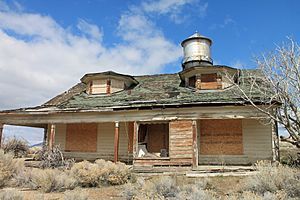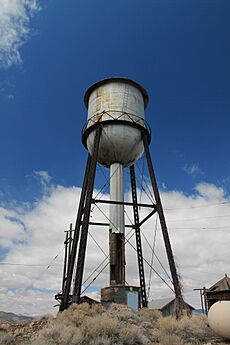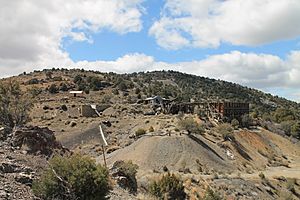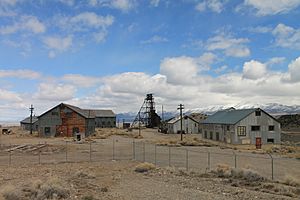Ruby Hill, Nevada facts for kids
Quick facts for kids
Ruby Hill
|
|
|---|---|

Remains of Ruby Hill, Nevada
|
|
| Country | United States |
| State | Nevada |
| County | Eureka |
| Elevation | 6,916 ft (2,108 m) |
Ruby Hill is a ghost town in Eureka County, Nevada. It is about 2.6 miles (4.2 km) west of the town of Eureka, Nevada. A ghost town is a place where most people have left, and many buildings are empty or ruined. In 1910, a big storm washed away the railroad that served Ruby Hill. After that, only three businesses were left in the town.
Contents
History
How Ruby Hill Started
In 1865, a Native American showed a special rock to three men: Owen Farell, M. G. Cough, and Alonzo Monroe. The men thought the rock might contain valuable minerals. They paid the Native American ten dollars to show them where he found it.
He led them to a spot about two and a half miles west of Eureka, Nevada. This place was on the northwestern side of Prospect Mountain. Here, the first mines, called Buckeye and Champion, were started.
The Town's Name
In the early 1870s, a mining town grew up around these mines. The town was named Ruby Hill because of a valuable mineral found there called pyragyrite. This mineral is also known as "ruby silver" because of its reddish color.
A post office opened in Ruby Hill on September 23, 1873. It stayed open until November 30, 1901. A railroad line was also built to serve the town. This railroad, named after Ruby Hill, carried the mined ore to special factories called smelters in Eureka. Smelters heat ore to separate the valuable metals.
Eureka County's Creation
Ruby Hill was part of Eureka County. This county was created in 1873 from a part of Lander County. It was formed to make things easier for people living in the area, including Ruby Hill. Before Eureka County existed, residents had to travel far to Lander County for official government business. The new county was named after the town of Eureka, which helped all the local residents.
Boom and Decline
Mining in Ruby Hill really took off around 1878. At its peak, the town had about 2,500 residents. Most of these people were miners and their families. Ruby Hill was a busy place with many stores, schools, churches, and even a theater. It also had a miners' union, a brewery, and a printing shop. The first copies of a newspaper called the Mining Report were printed there. It was later renamed the Mining News.
By 1880, the number of people in Ruby Hill began to drop. By 1885, only about 700 residents remained. They continued mining until the end of the 1800s. Some miners were able to rent land and search for new ore. A few even found untouched veins of valuable minerals.
The End of Ruby Hill
By the early 1900s, Ruby Hill had become very small, with only three businesses left. In 1910, a strong storm hit the area. It washed away the railroad tracks and many buildings. After this, most of the remaining townspeople left. Only one building from the 1800s was still standing.
This small mining camp was active for many years, producing almost $200,000 worth of minerals. The first important discovery was at the Cow and Calf Mine in 1871. The Ruby Hill Mining District was officially set up in July 1872. By August, Ruby Hill reached a small peak of about 150 people. It had two restaurants, two stores, a bar, and a boardinghouse.
However, by fall, the smaller mines ran out of ore. Legal problems forced the four largest mines to close, and the busy camp became empty. In the early 1880s, some mines briefly reopened. But this didn't last long, and by 1885, only two people lived there. There was some mining activity on and off until 1928, when all mining stopped for good. Because the camp was only active for short periods, not many strong, permanent buildings were ever built. Most of the old mines are high in the mountains and are very hard to reach today.




